SUBFAMILY FORMICINAE - Genus Anoplolepis
| The
Ants of Africa SUBFAMILY FORMICINAE - Genus Anoplolepis |
|
| Contents - Formicinae - FORMICINAE Introduction |
Revised after Bolton (2003: 267) - separating Anoplolepis as previously understood into two separate genera Anoplolepis (in Tribe Lasiini; with Zealleyella as a junior synonym) and Tapinolepis (in Tribe Plagiolepidini; with Mesanoplolepis as a junior synonym).
Bolton's prime separation points
are :-
Anoplolepis - mandible with 6-9
teeth, when closed not concealed by clypeus; dorsum of head behind
clypeus with erect stout setae; eye behind mid-length of head, and
anterior arc of torus around eyes posterior to and not touching clypeal
margin; ocelli absent (sometimes one median ocellus in largest
workers); metatibia with a large distinct apicoventral spur, with a
coarse seta on each side; anterior face of gaster without distinct
concavity.
Tapinolepis - mandible with 5
teeth, when closed mostly concealed by clypeus; dorsum of head behind
clypeus without erect stout setae; eyes set variably around midlength
of head but anterior arc of torus around eyes touching and slightly
indenting clypeal margin; three ocelli distinct; metatibia with a
divergent pair of large coarse setae on each side, no median spur;
anterior face of gaster with distinct cavity, into which the petiole
fits when alitrunk and gaster in horizontal alignment.
Link to Tapinolepis page.
The genus was originally described as a subgenus of Plagiolepis by Santschi (1914b: 123), raised to genus by Emery (1925b: 16), it appears as a full genus in Bolton (1994, 1995), but was not separated in Bolton (1973a). Most were originally placed in Formica or Plagiolepis.
The original separation of Anoplolepis as
a subgenus of Plagiolepis (Santschi 1914b) appears
to be a main ground of having the metanotum indistinctly defined or
obsolete (Arnold, 1922: 578-93). This feature was shared by two
subgenera -
Anoplolepis (Santschi,
1914b) with the meso-metanotal suture obsolete, the metanotum-propodeum
suture very feeble; dorsum of propodeum not very convex, not higher or
only slightly higher than the mesonotum; head hardly narrower in front
than behind; monomorphic, although in some, if not all species, some
workers are used as honey-storage vessels and have the abdomen grossly
distended.
Zealleyella Arnold (1922:
578-9) with the metanotum small, much smaller than the mesonotum, from
which it is feebly delimited; propodeum convex and higher than the
metanotum; large species often polymorphic.
Emery
(1925b) separated Tapinolepis as a new subgenus, with eyes
placed forward of the midline of the head; a single species from
Ethiopia. Santschi (1926a) clarified and
restated his definitions of the Genus and the subgenera Anoplolepis,
Zealleyella, Mesanoplolepis and Tapinolepis.
These are at ![]() ; together with a note on Mesanoplolepis
he added later (1930b - as to the subgenus having repletes but, unlike Zealleyella,
not different morphs in terms of head shape. All but one of the Mesanoplolepis
species are from eastern Africa, the odd one is from North Africa.
; together with a note on Mesanoplolepis
he added later (1930b - as to the subgenus having repletes but, unlike Zealleyella,
not different morphs in terms of head shape. All but one of the Mesanoplolepis
species are from eastern Africa, the odd one is from North Africa.
Bernard (1952) noted an unlabelled queen from Guinea (among the Mt. Nimba survey collection?), probably of the sub-genus Mesanoploplepis Santschi, of which queens were very poorly known. Bolton (1995) listed five species regarded as of this subgenus, all except Anoploplepis simulans (type location Tunisia) have type locations in southern Africa. Also it is only simulans of which the workers, males and queens are known. The South African species trimenii is known by workers and queens.
Typically, as in others of his generic revisions, Bolton synonymises subgenera and then creates species-groups, in this instance, under Anoplolepis, he wrote of the gracilipes group (being monomorphic) and the custodiens group (polymorphic).
Provisional key to workers from all Africa (based primarily on historical sources)
| 1 | 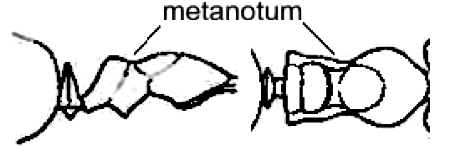 Polymorphic;
major workers with distinct ocelli,
none in minors; major workers with distinct metanotum; petiole with
erect scale, usually with distinct lateral vertical margination Polymorphic;
major workers with distinct ocelli,
none in minors; major workers with distinct metanotum; petiole with
erect scale, usually with distinct lateral vertical margination |
Anoplolepis subgenus Zealleyella - 2 |
| -- | 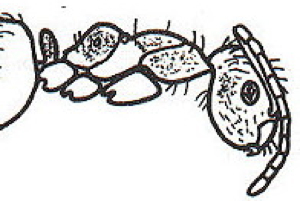 Monomorphic and
without
ocelli; first four segments of funiculus subequal; petiole with a thick
erect scale Monomorphic and
without
ocelli; first four segments of funiculus subequal; petiole with a thick
erect scale |
Anoplolepis subgenus Anoplolepis - 4 |
| Anoplolepis subgenus Zealleyella | - | |
| ¤ |  Queen & male
only known - type image available Queen & male
only known - type image available |
South Africa - nuptialis |
| ¤ | 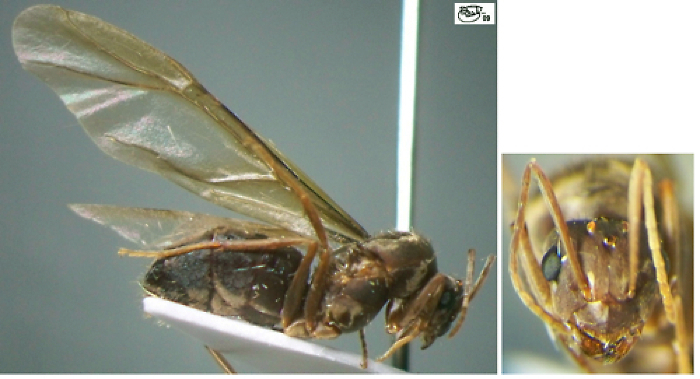 Queen only known; TL ca 11.0 mm, HW 1.85, HL 1.7, SL
2.0, CI 106, SI 106; clypeus with a sharp median carina; without dense
pubescence Queen only known; TL ca 11.0 mm, HW 1.85, HL 1.7, SL
2.0, CI 106, SI 106; clypeus with a sharp median carina; without dense
pubescence |
Central African Republic - samori new species |
| 2 | 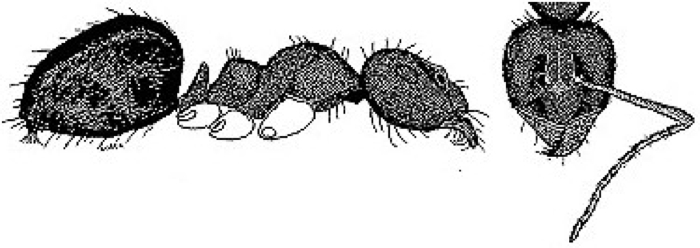 TL
(major) 9.0-9.5 mm; head large and wide (HW
2.2 mm), rounded and impressed posteriorly; propodeum with the dorsum
relatively shallowly convex and less convex and wider than others,
declivity near flat, even slightly concave between the spiracles;
entire body is sculptured with fine rugosity, densely packed giving a
shagreened appearance; mandibles are strongly longitudinally striate; whole
body covered in decumbent pubescence, greyish yellow, giving a
remarkably silky appearance, on gaster dorsum pubescence
forms five evenly separated longitudinal lines, running almost the
entirety of the gaster, one forming a median line; strong sparse erect
hairs on all parts of the body, more abundant on the posterior of the
gaster, the anterior of the clypeus and the mandibles; colour blood
red, with a slight brown tint; internal border of mandibles, apex of
antenna, frontal carinae, apex of petiole and gaster brown to near black TL
(major) 9.0-9.5 mm; head large and wide (HW
2.2 mm), rounded and impressed posteriorly; propodeum with the dorsum
relatively shallowly convex and less convex and wider than others,
declivity near flat, even slightly concave between the spiracles;
entire body is sculptured with fine rugosity, densely packed giving a
shagreened appearance; mandibles are strongly longitudinally striate; whole
body covered in decumbent pubescence, greyish yellow, giving a
remarkably silky appearance, on gaster dorsum pubescence
forms five evenly separated longitudinal lines, running almost the
entirety of the gaster, one forming a median line; strong sparse erect
hairs on all parts of the body, more abundant on the posterior of the
gaster, the anterior of the clypeus and the mandibles; colour blood
red, with a slight brown tint; internal border of mandibles, apex of
antenna, frontal carinae, apex of petiole and gaster brown to near black |
. |
| . | 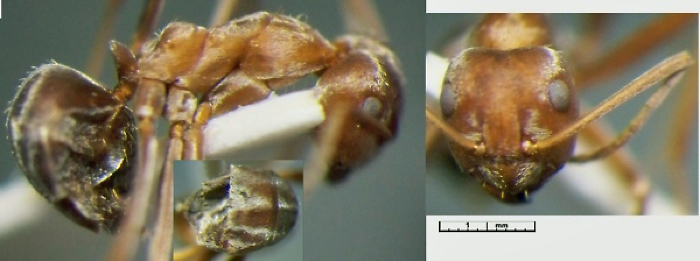 |
Eastern & southern Africa - custodiens |
| -- | Without a distinctively patterned covering of silky pubescence | 3 |
| 3 | 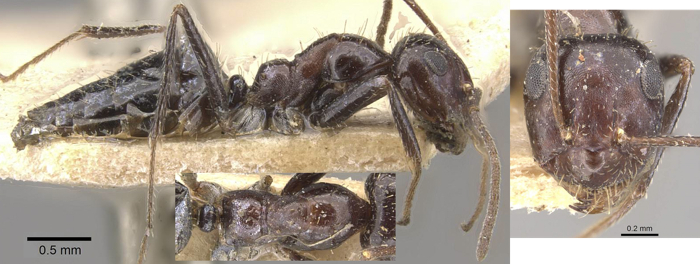 TL 3.1-5.1 mm; petiole profile relatively low and thick;
without obvious pubescence; dark red-brown, shiny TL 3.1-5.1 mm; petiole profile relatively low and thick;
without obvious pubescence; dark red-brown, shiny |
South Africa - vestita |
| -- | General colour orange-brown | 3 |
| -- |  With spaced out pale pubescence With spaced out pale pubescence |
South Africa - fallax |
| -- | 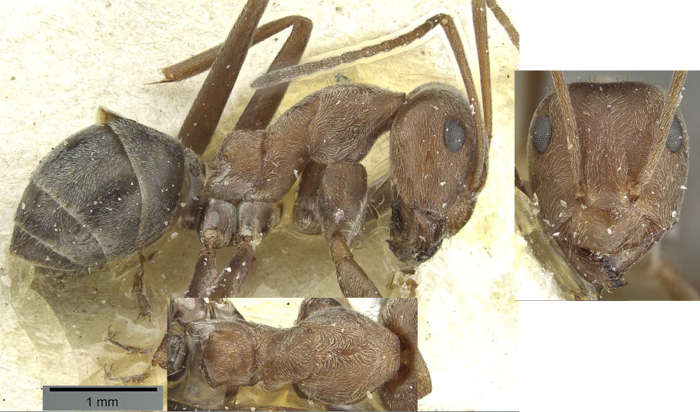 Possibly synonymous with fallax; major TL ca 5
mm,
minor TL ca 3.0 mm Possibly synonymous with fallax; major TL ca 5
mm,
minor TL ca 3.0 mm |
South Africa - parsonsi |
| -- | 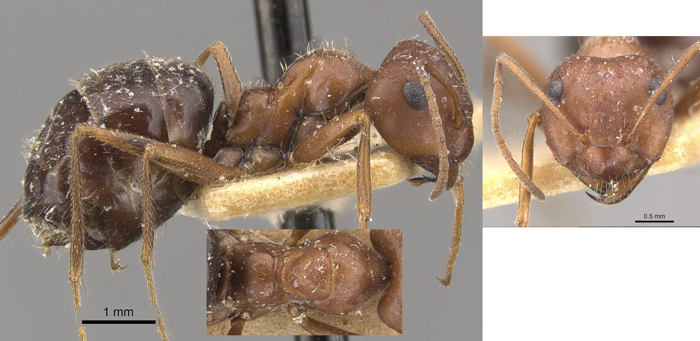 TL 2.7-7.0 mm; scape
surpasses occiput by less than one-third its own length; propodeum
relatively short with high convexity, petiole scale quite thin; head
densely punctate-rugulose, alitrunk superficially rugulose; without
silky pubescence; colour dark rusty-reddish brown TL 2.7-7.0 mm; scape
surpasses occiput by less than one-third its own length; propodeum
relatively short with high convexity, petiole scale quite thin; head
densely punctate-rugulose, alitrunk superficially rugulose; without
silky pubescence; colour dark rusty-reddish brown |
Southern Africa - steingroeveri |
| -- | 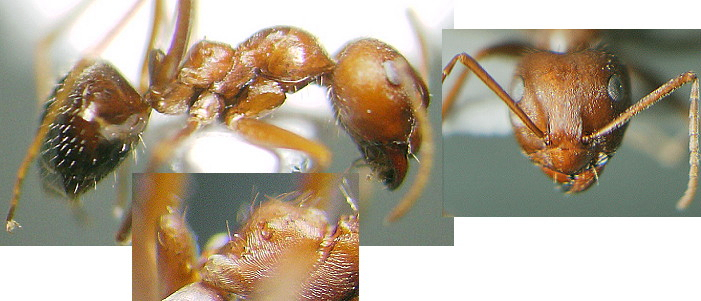 TL
3.3 (minor)-6.0 mm (major); scape surpasses
occiput by one-third of its length; head quadrate, sides moderately
convex, posterior angles slightly rounded and occiput straight;
sculpturation fine and overall shiny; erect pilosity yellowish, fairly
dense on head and alitrunk; major colour pale chestnut brown, genae
yellowish, appendages lighter TL
3.3 (minor)-6.0 mm (major); scape surpasses
occiput by one-third of its length; head quadrate, sides moderately
convex, posterior angles slightly rounded and occiput straight;
sculpturation fine and overall shiny; erect pilosity yellowish, fairly
dense on head and alitrunk; major colour pale chestnut brown, genae
yellowish, appendages lighter |
South Africa - rufescens |
| Anoplolepis subgenus Anoplolepis | - | |
| ¤ | Queen only known; TL 9 mm, HW = HL
1.7; alirunk dorsum with longer and more abundant erect hairs than P. custodiens - images on species
page |
Gabon - opaciventris |
| 4 | 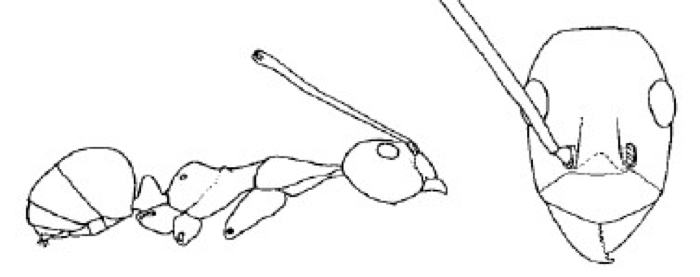 TL
3.8-4.2 mm; slender with scapes longer than
body; legs also long and slender, posterior pair one-third longer than
whole ant; pale erect hairs sparse; colour rufous-testaceous, gaster
darker, appendages pale TL
3.8-4.2 mm; slender with scapes longer than
body; legs also long and slender, posterior pair one-third longer than
whole ant; pale erect hairs sparse; colour rufous-testaceous, gaster
darker, appendages pale |
. |
| . |  |
Only Zanzibar in Africa - gracilipes |
| -- | Generally stockier without obvious elongation | 5 |
| 5 | 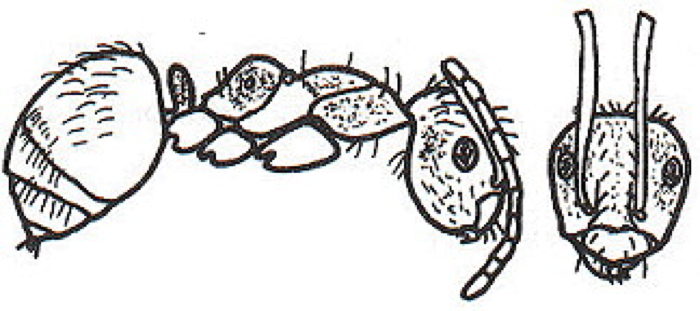 TL
3.2-3.5 mm; head distinctly narrower
anteriorly; mandibles finely striate; dorsum of propodeum rounded,
declivity flat, slightly
concave basally and twice as long as dorsum, with a distinct angle at
junction of dorsum and declivity; head and alitrunk densely and finely
punctate, matt; gaster
microscopically reticulate, with a silky appearance; rust coloured,
pointed, erect hairs quite long on head and gaster; colour testaceous
yellow, gaster brown TL
3.2-3.5 mm; head distinctly narrower
anteriorly; mandibles finely striate; dorsum of propodeum rounded,
declivity flat, slightly
concave basally and twice as long as dorsum, with a distinct angle at
junction of dorsum and declivity; head and alitrunk densely and finely
punctate, matt; gaster
microscopically reticulate, with a silky appearance; rust coloured,
pointed, erect hairs quite long on head and gaster; colour testaceous
yellow, gaster brown |
. |
| . | 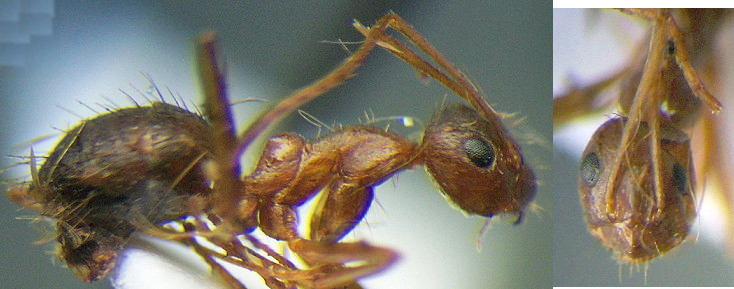 |
West Africa & Congo Basin - tenella |
| -- | 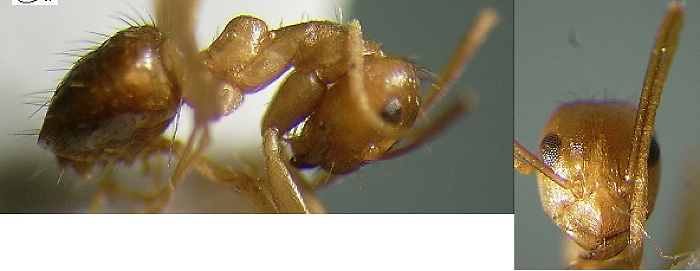 TL
3.5-3.75 mm; head evenly ovoid, as long as
wide, sides arcuate, and posterior angles strongly rounded, giving the
head the shape of a rounded square; large eyes set posterior of the
mid-point of the head; clypeus distinctly carinate, anterior border
with a median obtuse angle; mandibles smooth; propdeum profile with
convex dorsum rounding smoothly into the weakly concave declivity;
petiole scale high but cuneiform, with a
rounded dorsal profile; apparently with much more numerous erect hairs
than the other species; head and alitrunk matt due to dense microscopic
puncturation; more superficial on the gaster; colour testaceous yellow,
head and gaster slightly darker, appendages paler. TL
3.5-3.75 mm; head evenly ovoid, as long as
wide, sides arcuate, and posterior angles strongly rounded, giving the
head the shape of a rounded square; large eyes set posterior of the
mid-point of the head; clypeus distinctly carinate, anterior border
with a median obtuse angle; mandibles smooth; propdeum profile with
convex dorsum rounding smoothly into the weakly concave declivity;
petiole scale high but cuneiform, with a
rounded dorsal profile; apparently with much more numerous erect hairs
than the other species; head and alitrunk matt due to dense microscopic
puncturation; more superficial on the gaster; colour testaceous yellow,
head and gaster slightly darker, appendages paler. |
West Africa & Congo Basin - carinata |
| Subfamily Formicinae |
©
2007, 2008, 2009, 2010, 2011, 2013, 2014, 2017 - Brian Taylor CBiol FRSB FRES 11, Grazingfield, Wilford, Nottingham, NG11 7FN, U.K. |
href="anoplolepis.htm"